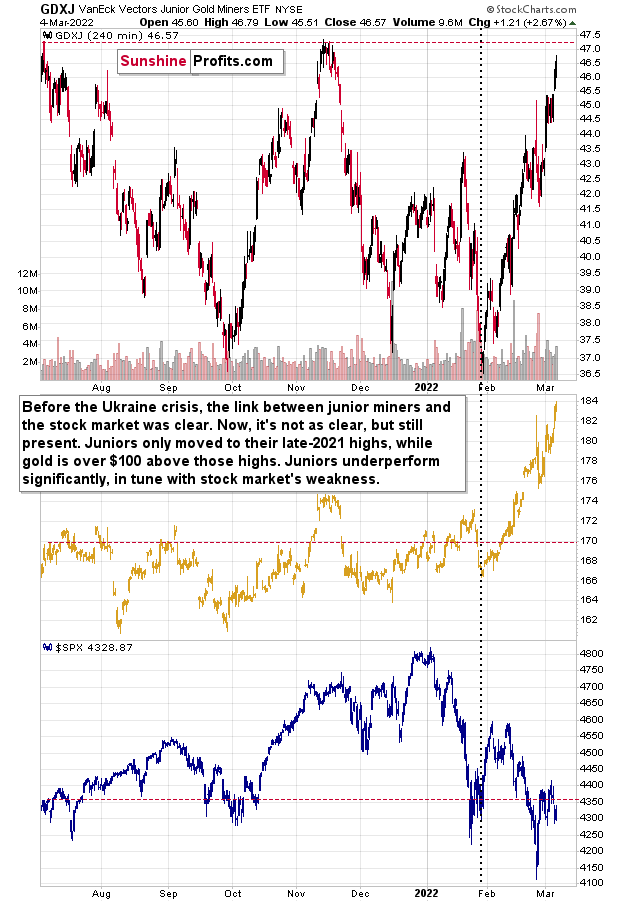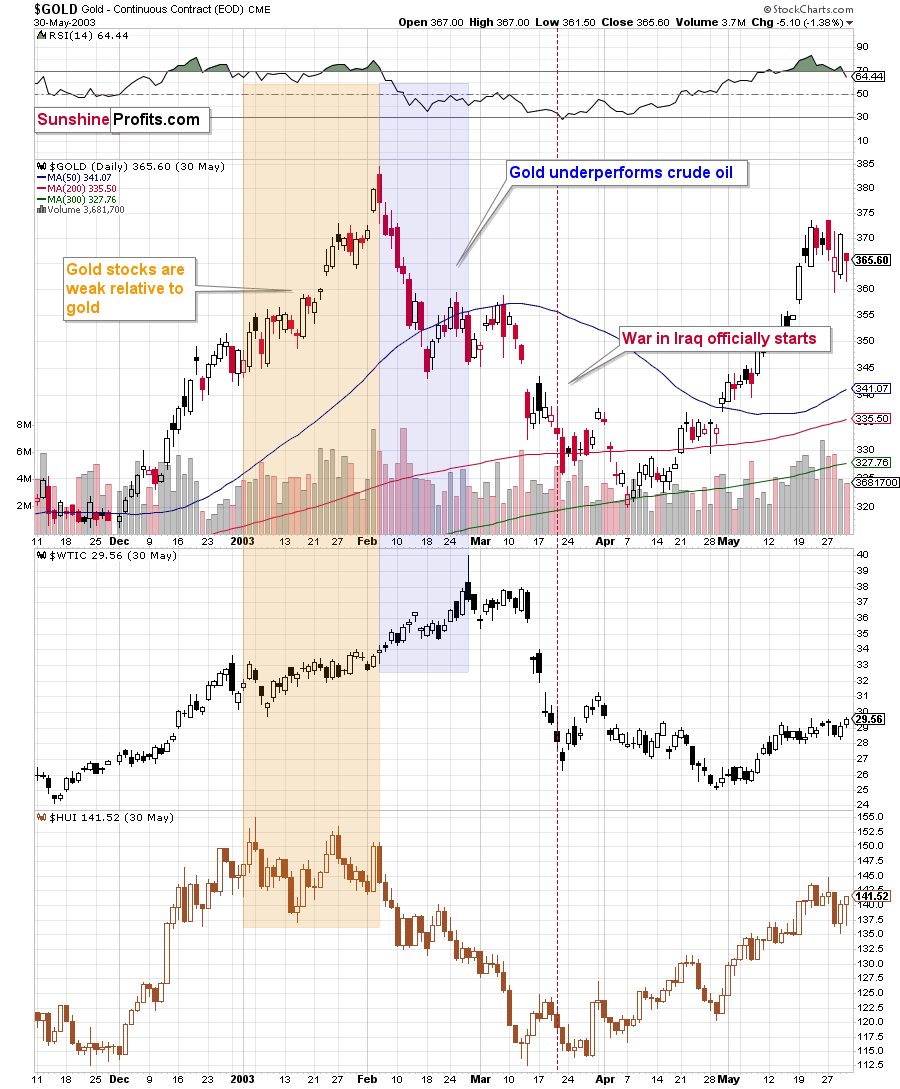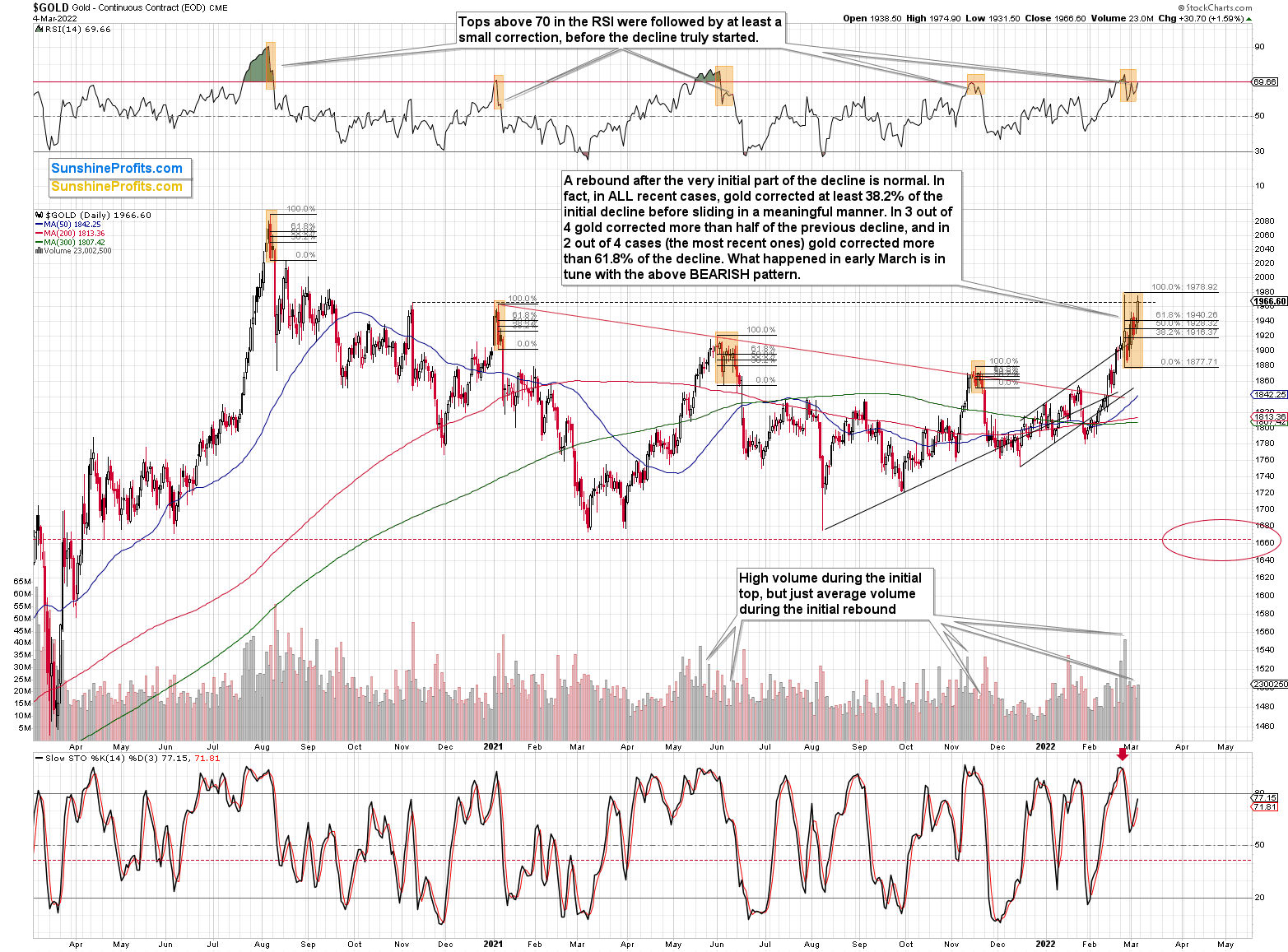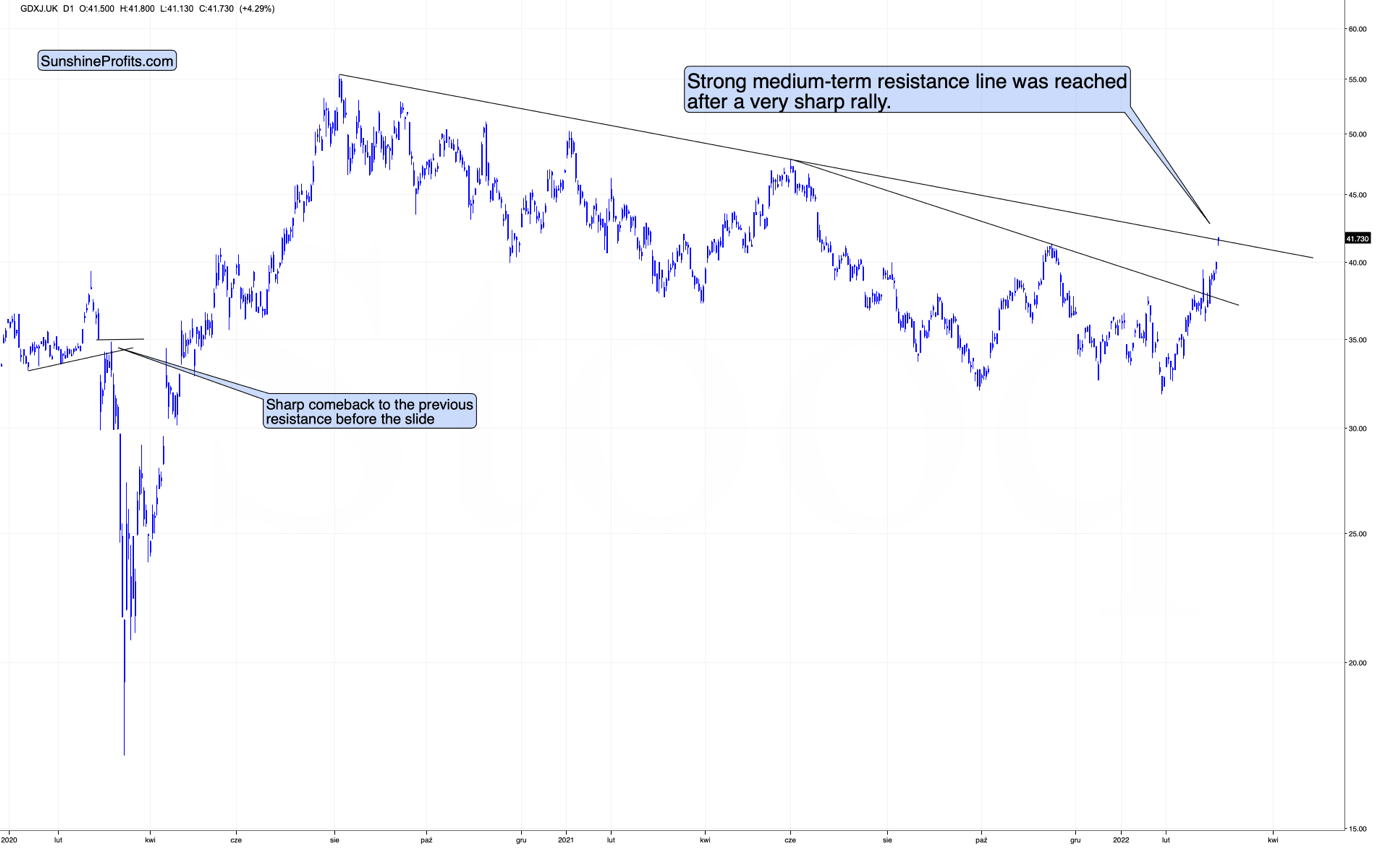Crude oil did it again! Even though gold moved higher recently, crude oil soared so substantially that it stole practically the entire spotlight. Let’s take a look at it before moving to the precious metals sector.
The price of crude oil soared by almost $40 in just a bit over a week! That’s over 40%. Gold rallied too, but the extent of the move higher is nothing compared to what we just saw in crude oil.
The black gold reversed on an intraday basis yesterday, so we might have seen the top, but it’s far from being clear. What is clear, however, is that crude oil is greatly outperforming gold.
This—as I’ve commented previously—has profound implications for precious metals investors:
"As you may have noticed, crude oil shot up recently in a spectacular manner. This seems normal, as it’s a market with rather inflexible supply and demand, so disruptions in supply or threats thereof can impact the price in a substantial way. With Russia as one of the biggest crude oil producers, its invasion of Ukraine, and a number of sanctions imposed on the attacking country (some of them involving oil directly), it’s natural that crude oil reacts in a certain manner. The concern-based rally in gold is also understandable.
"However, the relationship between wars, concerns, and prices of assets is not as straightforward as '“there’s a war, so gold and crude oil will go up.”' In order to learn more about this relationship, let’s examine the most similar situation in recent history to the current one, when oil supplies were at stake.
"The war that I’m mentioning is the one between Iraq and the U.S. that started almost 20 years ago. Let’s see what happened in gold, oil, and gold stocks at that time.
"The most interesting thing is that when the war officially started, the above-mentioned markets were already after a decline. However, that’s not that odd, when one considers the fact that back then, the tensions were building for a long time, and it was relatively clear in advance that the U.S. attack was going to happen. This time, Russia claimed that it wouldn’t attack until the very last minute before the invasion.
"The point here, however, is that the markets rallied while the uncertainty and concerns were building up, and then declined when the situation was known and “'stable.'” I don’t mean that '“war”' was seen as stable, but rather that the outcome and how it affected the markets was rather obvious.
"The other point is the specific way in which all three markets reacted to the war and the timing thereof.
"Gold stocks rallied initially, but then were not that eager to follow gold higher, but that’s something that’s universal in the final stages of most rallies in the precious metals market. What’s most interesting here is that there was a time when crude oil rallied substantially, while gold was already declining.
"Let me emphasize that once again: gold topped first, and then it underperformed while crude oil continued to soar substantially.
"Fast forward to the current situation. What has happened recently?"
Gold touched $2,000 in Monday's pre-market trading, which was barely above its 2021 high and below its 2020 high. Crude oil was way above both analogous levels. In other words, gold underperformed crude oil to a significant extent, just like in 2003.
Interestingly, back in 2003, gold topped when crude oil rallied about 40% from its short-term lows (the late-2002 low).
"What happened next in 2003? Gold declined, and the moment when crude oil started to visibly outperform gold was also the beginning of a big decline in gold stocks.
"That makes perfect sense on the fundamental level too. Gold miners’ share prices depend on their profits (just like it’s the case with any other company). Crude oil at higher levels means higher costs for the miners (the machinery has to be fueled, the equipment has to be transported, etc.).
"When costs (crude oil could be viewed as a proxy for them) are rising faster than revenues (gold could be viewed as a proxy for them), miners’ profits appear to be in danger; and investors don’t like this kind of danger, so they sell shares.
"Of course, there are many more factors that need to be taken into account, but I just wanted to emphasize one way in which the above-mentioned technical phenomenon is justified. The above doesn’t apply to silver as it’s a commodity, but it does apply to silver stocks.
"Back in 2003, gold stocks wiped out their entire war-concern-based rally, and the biggest part of the decline took just a bit more than a month. Let’s remember that back then, gold stocks were in a very strong medium- and long-term uptrend. Right now, mining stocks remain in a medium-term downtrend, so their decline could be bigger – they could give away their war-concern-based gains and then decline much more.
"Mining stocks are not declining profoundly yet, but let’s keep in mind that history rhymes – it doesn’t repeat to the letter. As I emphasized previously today, back in 2003 and 2002, the tensions were building for a longer time, and it was relatively clear in advance that the U.S. attack was going to happen.
"This time, Russia claimed that it wouldn’t attack until the very last minute before the invasion. Consequently, the “we have to act now” is still likely to be present, and the dust hasn’t settled yet – everything appears to be unclear, and thus the markets are not returning to their previous trends. Yet.
"However, as history shows, that is likely to happen. Either immediately, or shortly, as crude oil is already outperforming gold."
The above chart features the VanEck Junior Gold Miners ETF (NYSE:GDXJ) (LON:GDXJ) in its London trading. As you can see, the junior miners moved to their very strong resistance provided by the declining resistance line. This resistance seems to be analogous to the $2,000 level in gold.
By the way, please note that gold tried to break above $2,000 several times:
- twice in August 2020;
- twice in September 2020 (once moving above it, once moving just near this level);
- once in November 2020 (moving near this level);
- once in January 2021 (moving near this level);
- once in February 2022 (moving near this level).
These attempts failed in each of the 7 cases mentioned above. This has been the eight attempt.
Given how much crude oil has already soared, and how both markets used to react to war tensions in the case of oil-producing countries, it seems that the days of the rally are numbered.
Moving back to the GDXJ ETF, please note that while gold is moving close to its all-time highs, the junior miners are not doing anything like that. In fact, they barely moved slightly above their late-2021 high. They are not even close to their 2021 high, let alone their 2020 high. Instead, junior mining stocks are just a bit above their early-2020 high, from which their prices were more than cut in half in less than a month.
In other words, junior miners strongly underperform gold, which is a bearish sign. When gold finally declines—and it’s likely to, as geopolitical events tend to have only a temporary effect on prices, even if they’re substantial—junior miners will probably slide much more than gold.
One of the reasons is the likely decline in the general stock market.
I recently received a question about the impact the general stock market has on mining stocks, as the latter moved higher despite stocks’ decline in recent weeks. So, let’s take a look at a chart that will feature junior mining stocks, the SPDR® Gold Shares (NYSE:GLD) ETF, and the S&P 500 Index.

Before the Ukraine crisis, the link between junior miners and the stock market was clear. Now, it's not as clear, but it’s still present. Juniors only moved to their late-2021 highs, while gold is over $100 above those highs. Juniors underperform significantly, in tune with the stock market's weakness.
The gold price is still the primary driver of mining stock prices—including junior mining stocks. After all, that’s what’s either being sold by the company (that produces gold) or in the properties that the company owns and explores (junior miners). As gold prices exploded in the last couple of weeks, junior miners practically had to follow. However, this doesn’t mean that the stock market’s influence is not present, nor that it’s going to be unimportant going forward.
Conversely, the weak performance of the general stock market likely contributed to junior miners’ weakness relative to gold—the former didn’t rally as much as the latter.
Since the weakness in the general stock market is likely to continue, and gold’s rally is likely to be reversed (again, what happened in the case of other military conflicts is in tune with history, not against it), junior miners are likely to decline much more profoundly than gold.




